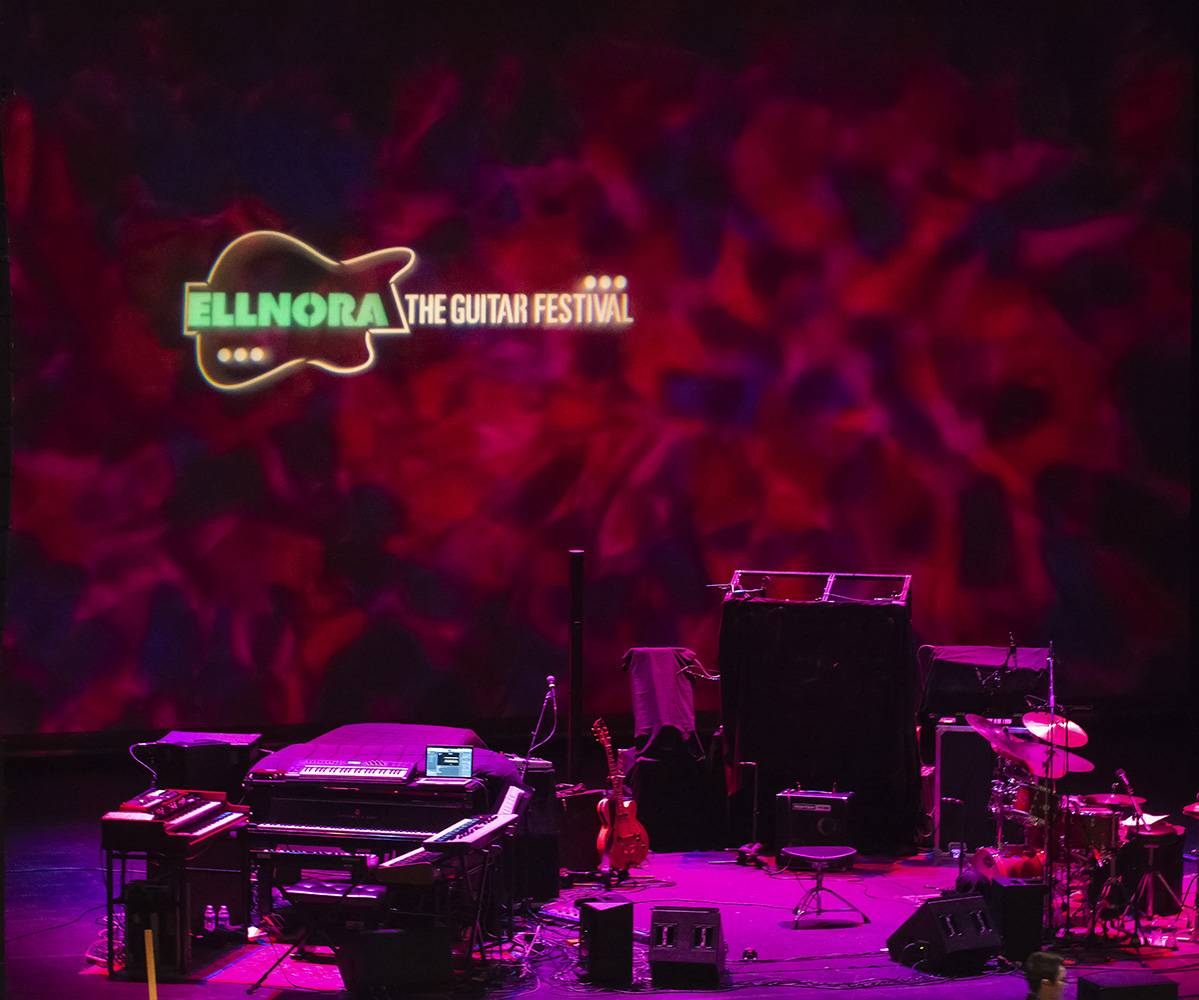A collective of writers made their way to ELLNORA at Krannert Center this past weekend — check out what they had to say, and the moments captured in photos as well along the way.
THURSDAY
SAMANTHA FISH, LUTHER DICKINSON, TOKO TELO, SPONTANEOUS COMBUSTION
The eighth edition of ELLNORA: The Guitar Festival officially got underway at Krannert Center with an undeniably talented, wide-ranging assortment of acts that drew hundreds of folks out on Thursday evening.
Madagascar-based folk group Toko Telo kicked things off with as the sun set behind them and a buzzing Krannert amphitheater looked on. Consisting of vocalist Monika Njava and guitarists D’Gary and Joël Rabesolo, the group delivered a vibrant performance, with Njava’s vocals coming across powerfully over the harmonizing guitars of her companions.

Toko Telo
Lots of families popped out for the earlier stages of the Opening Night Party, which featured Nigerien star Bombino and a joint set from accomplished blues figures Samantha Fish and Luther Dickinson.
Toko Telo’s set was certainly a family favorite, as the group’s set attracted a bunch of younger kids who danced gleefully before the stage while some of their parents looked on in adoration.
Inside Krannert, Nigerien star Bombino captivated with energetic tichumaren, North African desert blues. He and his band brought unrelenting energy — and a bit of rockstar aura — to the night, building up to electrifying riffs and solos that were just sensational. As Bombino’s set went on, more and more folks filed into Krannert, the group belted off scintillating assortments of sound and was ultimately met with a booming ovation by the end of the set.



Bombino
The vibes switched pretty seamlessly as the crowd migrated to the other side of the lobby, where pre-war blues master Reverend Robert played a brief set. His more traditional acoustic song especially played to some of the older folks’ preferences in the crowd, as he sat and plucked away on his guitar, before ending his set on the ukulele.
Not long after, blues singer-songwriter and guitarist Samantha Fish and former Black Crowes guitarist Luther Dickinson joined together for a special set before the largest crowd of the night.
Fish’s confident, alluring vocals met with Dickinson’s charismatic riffs were a hit as the mood shifted to a slightly edgier feel. Dickinson, who now plays with the North Mississippi Allstars — with whom he’s been nominated for three Grammy awards for Best Contemporary Blues Album — at one point remarked that they were playing “love-making music”, which drew some laughs and yells of agreement from the crowd, which was several hundred strong. Dickinson let Fish handle most of the vocals, while firing off powerful, invigorating riffs behind.
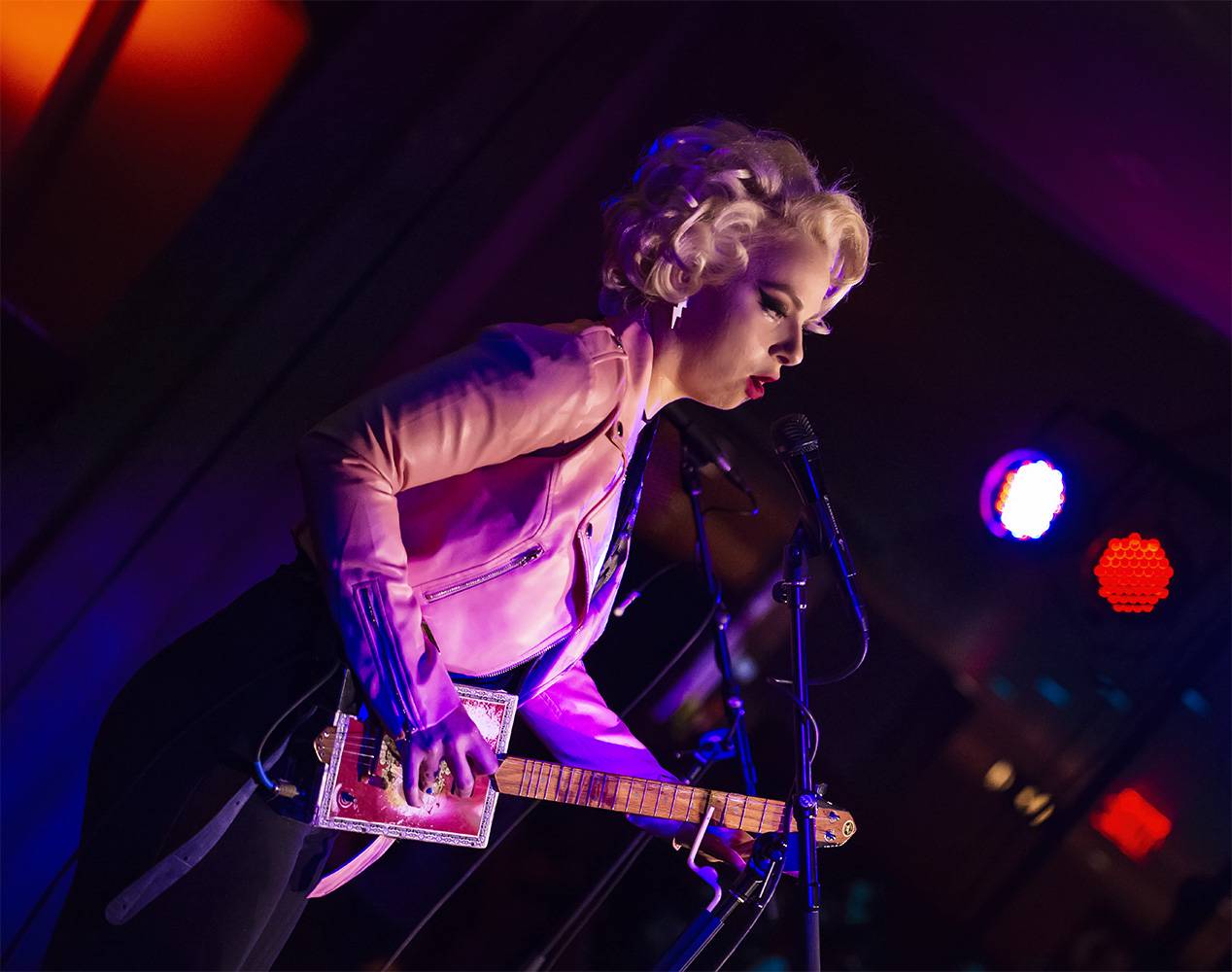
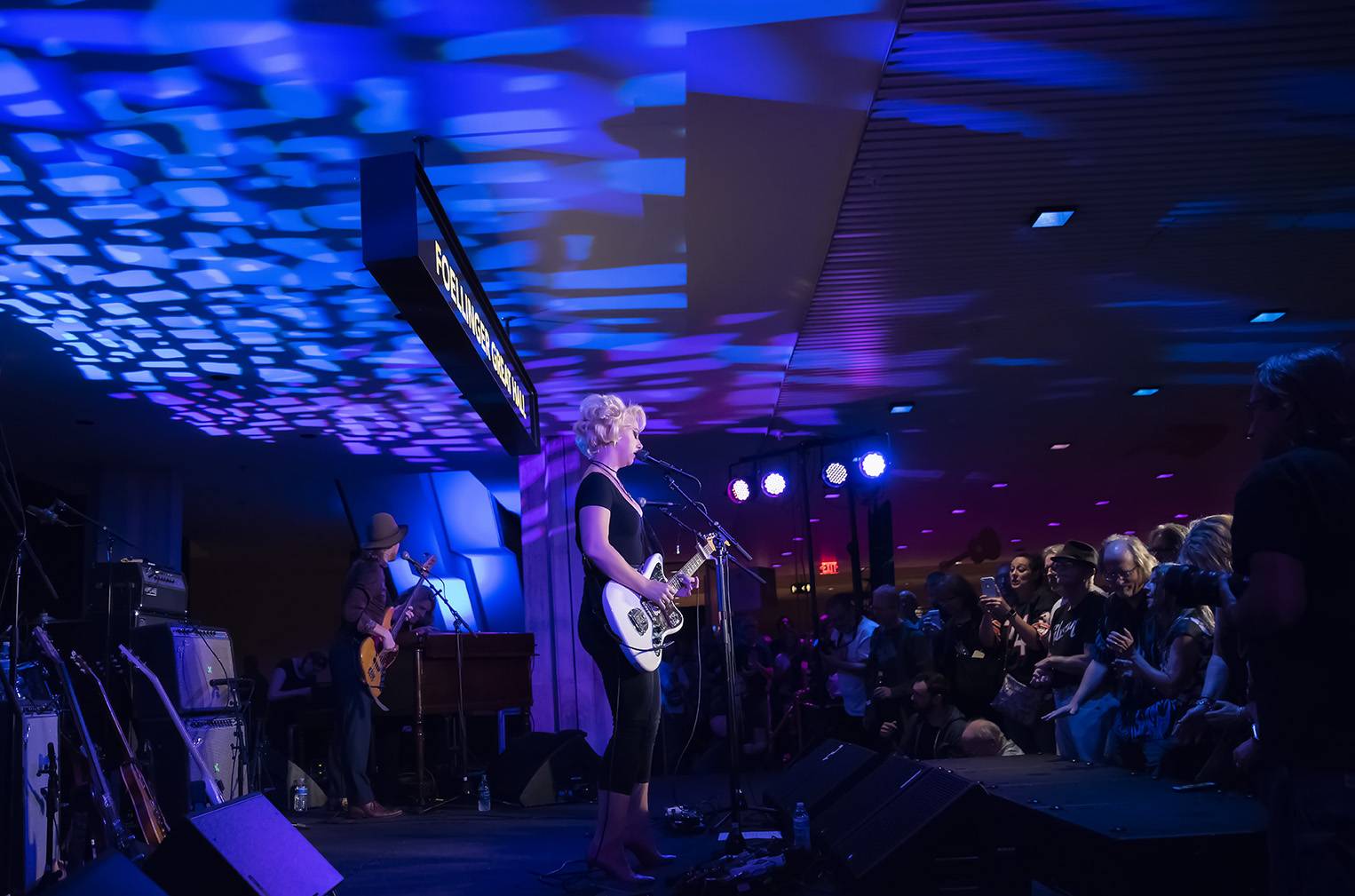
Samantha Fish
Their set was the conclusion of the free programming for the night as things peaked with Spontaneous Combustion, an assortment of six guitarists — including Dickinson – that joined together for an entirely improvised performance.
Converging on the Studio Theatre, which has club-style seating in front of the stage and lining the sides of the room, a bevy of renowned string practitioners laid down a bunch of sounds.
Dickinson was joined by blues guitarist Steve Dawson, who played at Krannert in the spring, Grammy-winning pair Trey Hensley and Rob Ickes and International Bluegrass Music Association Guitarist of the Year Molly Tuttle.
 Spontaneous Combustion
Spontaneous Combustion

Molly Tuttle
Starting off slowly, each guitarist began to do their own thing, spinning styles and blending into harmony for an unscripted hour-and-45-minute set.
It was off-the-cuff for sure, but each musician’s prowess shined through clearly as it rarely seemed like it was just improvisation.
Early on, Hensley — who was nominated for a Grammy for Best Bluegrass Album of the Year in 2015 along with Hensley for their album, Before the Sun Goes Down — seized the spotlight with a sizzling solo that elicited a large round of applause from the crowd.
Dawson dipped and bowed around next to Dickinson on the left side of the stage as Dawson’s real bluesy play set the tone for Ickes, who played his dobro like it was a laptop keyboard, his fingers gliding all about.
About midway through the performance, Dawson and Hensley broke off into their own duo, trading shots back and forth with Dickinson, Tuttle and Ickes.
Dickinson led the way as he played a song he wrote at a recording session for his late father, titled “Let It Go”. Before beginning, he spoke of how his father — a prominent producer in his day — strongly disliked funerals, but loved recording sessions.
The one-off performance hit its end just after 11 p.m., capping a booming start for ELLNORA, which seems set to sparkle as a centerpiece of the Krannert Center’s 50-year anniversary celebrations. (GG)
FRIDAY
STEPHANIE WREMBEL
A little after 8 p.m. on Friday, guitarist Stephanie Wrembel walked on to the stage in the Krannert’s Studio Theatre, sat down, and began telling stories. Dressed in black, with a prodigious head of silver hair tied back into a tight ponytail, Wrembel spoke at length about the late French guitarist, Django Reinhardt, known the world over for his swing and (bal)-musette compositions and performances and, perhaps most famously, for the minor sixth chords, 4-to-a-bar strumming, and chromatic runs of his unique take on gypsy-influenced jazz.
In his slightly sarcastic and, at times, deeply philosophical discourse, he highlighted different aspects of Reinhardt’s stylistic evolution beginning with it’s rooted admiration for and imitation of French “Impressionist” composers like Debussy and Satie. This inspiration was clearly illustrated as Wrembel opened his performance with three solo pieces written by Reinhardt, “Improvisation #1”, “Improvisation #2” (parts of which sounding like a forgotten section of “Clair De Lune”), and “Improvisation #3”, all short works that alternated between airy, moody chord progressions and furious technical fireworks. In between the second and third songs, he took a moment to note that none of the compositions were, in fact, actually “improvised” and then expressed his distaste for the limitedness of the term noting that “when you compose, you improvise and when you improvise, you are composing”, an insight that was hopefully not lost on the somewhat lethargic crowd.
He played the rest of his set accompanied by the other members of his quartet (a drummer, electric bassist, and acoustic rhythm guitarist) and proceeded to turn up the tempo and volume. This portion of the performance focused on the music Reinhardt played during the bar and dancehall musette and swing gigs of his teenage years as well as his adoption of the style and sounds of early American jazz greats like Louis Armstrong. As the band expertly navigated their way through pitch-perfect covers of well-known Reinhardt classics like “Nuages” and “Minor Swing”, trading solos and laying the rhythmic foundations for Wrembel’s impossibly fast, technically adventurous solos, the audience was transported to the Roaring Twenties and the late-night murk of a Parisian club. And while the KCPA did an admirable job transforming the Studio Theatre into a cabaret of sorts, this performance may have been better suited for the kind of venue that smells of spilt wine, stale cigarette smoke, and the sweat of a throng of people vigorously dancing the night away. — John Kotnarowski
PAT METHENY
Pat Metheny threw the audience at Krannert”s Tryon Festival Theatre down a multitude of musical rabbit-holes and through dozens of sonic looking-glasses. His Side Eye tour/project is an exercise in “pay it forward” mutual exploration. During his formative years in Kansas City, Missouri, he was given chances to work and develop by a few key journeymen. Ever the innovator, he conceived of expanding his material in a humanistic direction in addition to his musical pursuits.
To this end, he operates a revolving pool of young musicians who have caught his interest. As he posited in his self-introduction, “it’s exiting to see how these young people deal with music.” It was an apt way to describe what it means to work in the jazz idiom. This particular combo is a trio, comprised of keyboardist and Blue Note recording artist, James Francies and Marcus Gilmore, Latin Grammy Award-winning percussionist who happens to be Roy Haynes’ grandson.
The stage glittered fuchsia in a warm way, as Metheny simply walked out from center stage — outfitted with his omnipresent striped, long-sleeved t-shirt and white leather sneakers. After the other two musicians took their places at their rigs, the combo began with, “So It May Secretly Begin” from the Grammy Award-winning album, Still Life (Talking). Metheny’s tone was the dark, neon-violet ring that has come to be expected by his followers. Most songs started as solo cadenzas with elaborate textures. The time-honored practice of each player having bars over which to solo, was represented here. Francies evinced a style in both his comping and soloing, that immediately validated his claim of having synesthesia–the perceptual phenomenon in which one cognitive pathway, produces immediate sensation in a second. Francies’ playing could be described as what Zappa called, “air sculptures.” To certain types of intellect, the sound also appears as pictures.
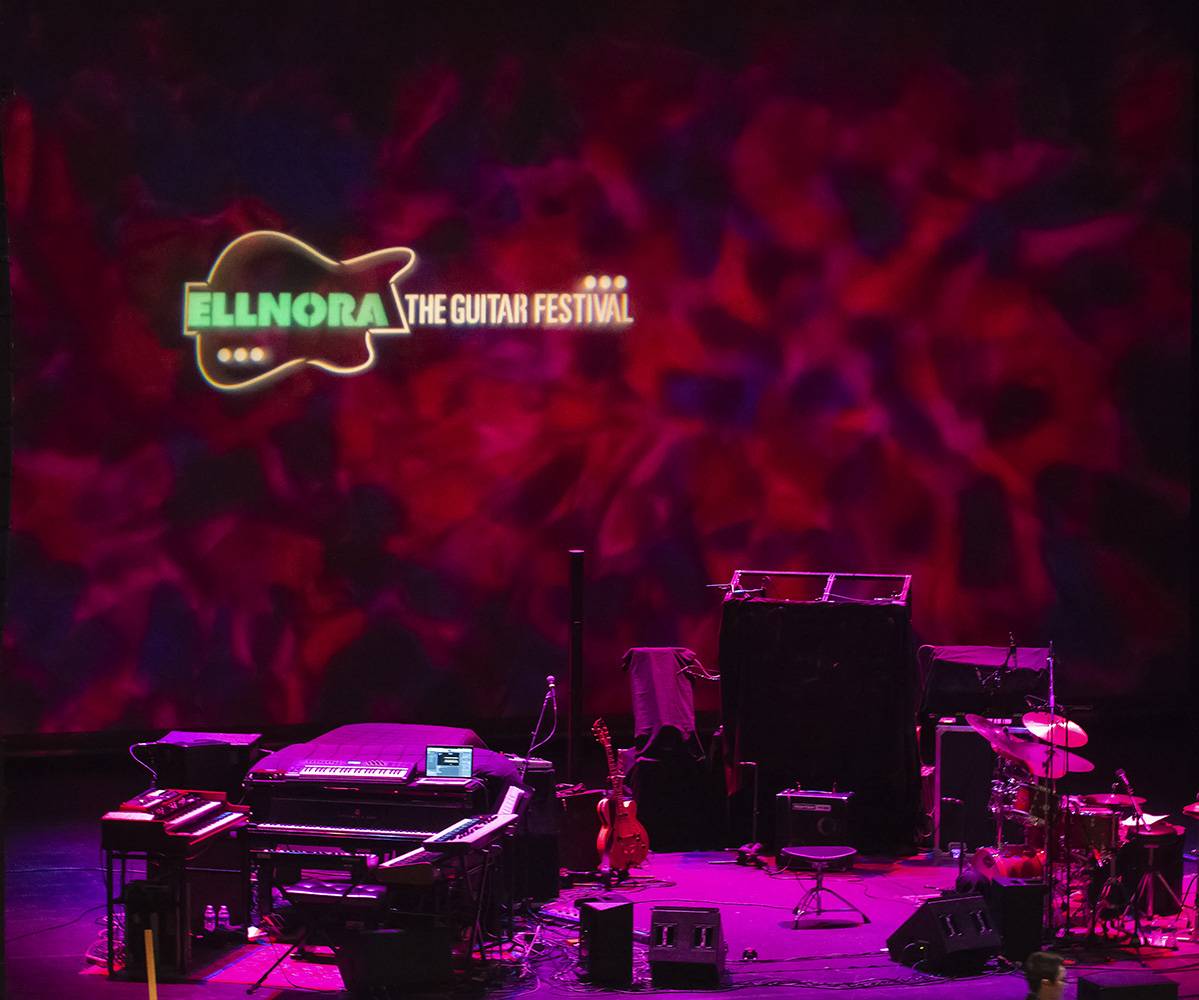
Maybe the most interesting component of Francies’ “bag” was his ability to cover the lines with synthesizer, that under most Jazz playing situations, would be spoken with an upright bass, The patch was so realistic, that the listener would assume that a actual upright bass-player was present. This was apparent during quieter, less note-dense passages, but was so well executed and assimilated, that during frantic passages with close tempos, it disappeared within arrangements.
The inter-ensemble musical communication was seamless. Under ideal circumstances, the musicians should be “speaking” to each other — using musical figures and phrases that interlock between players. This was an ideal circumstance.
As the combo moved through Metheny’s canon and selected bits such as, “Question And Answer”, “Better Days Ahead”, and a song produced with guitarist, John Scofield, (“The Red One”) the pervading mood seemed to surge progressively as the form of each offering was stretched and bent. Metheny’s descending chromatic runs and ascending diversions, seemed to be placed at just the right moments so as to provide a break for the listener to “reset” for the next phrase. His style is comprised not only of decidedly jazz-inflected “licks,” but also finger-style use of open strings and horizontal movement through chord-scales.
He began on a blonde, arch top guitar, but moved tastefully to steel-string acoustic, and of course, use of the Roland GR-303 guitar synthesizer, the use of which in jazz, he pioneered. Towards the end, he employed a forty-two string Pikasso acoustic guitar, arranged with sympathetic string-groups. This had a sort of asian sound, with sprinklings of Hindustani strums, as on a vina.
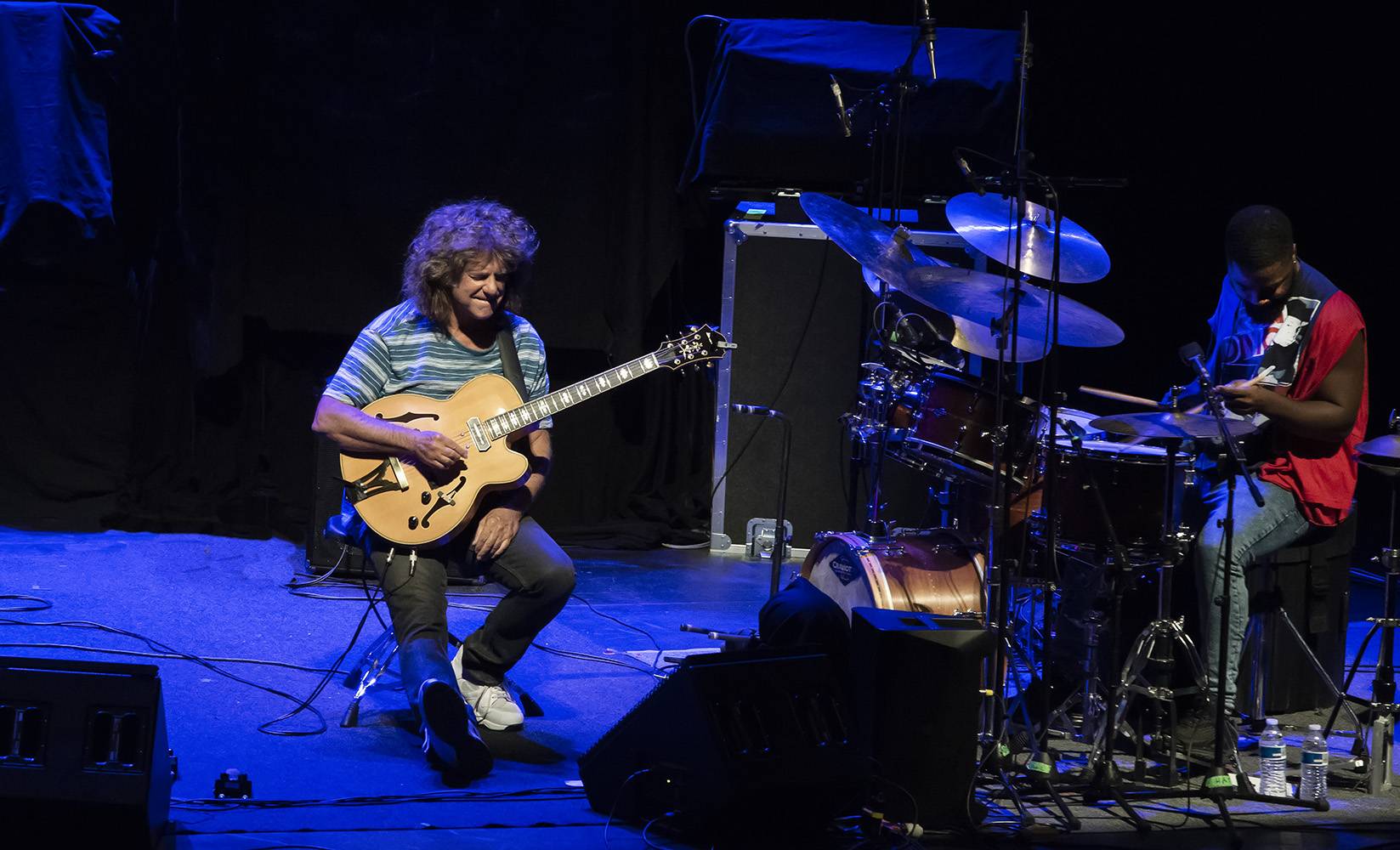

Pat Metheny
Percussionist, Gilmore was running along side — and with — the other two players with precision accompaniment and joint-fluid hi-hat play. His snare had the sandy aspects indicative of that drum, but also possessed a piccolo crack — again, as with Metheny, placed at deliberate landings. His solos — the few of them that there were — existed as so musical, that even the casual listener would be captivated and made to follow their developments. He is young — aged thirty-three years.
Metheny’s encore was performed solo, on steel-string acoustic guitar. Up until the beginning of this, the mood parabola moved between dark, thought provocation and dizzying exhilaration. It was here, that he provided the only comic-relief of the evening. The opening figure of his well-known song, “Phase Dance” chimed out briefly — then stopped, with a mischievous grin, he moved instead to a sort of medley, containing “Last Train Home” and “Minuano” in six-eight, “This Is Not America” (from his collaboration with David Bowie).
The effect of the entire evening was a kind of flash-feed fatigue and cerebral vertigo. The audience contained many musicians, so this was probably epidemic. Pat Metheny along with Francies and Gilmore demonstrated exactly how spiritual the connection between audience and performers can be — and the fact that there are no limits on the quality of musicianship humans can achieve. (JI)
THE MESSTHETICS
Closing out the second night of ELLNORA, in front of a crowd that probably should have been a lot bigger, The Messthetics put on easily one of the best shows I’ve seen all year. Comprised of guitarist Anthony Pirog, bassist Joe Lally, and drummer Brendan Canty (formerly the rhythm section for post-hardcore outift Fugazi), they’re commonly billed as a power trio with a fondness for pushing rhythmic and sonic limits. However, their style is challenging to define. Other reviews have described it as “experimental” (whatever that means) and “jazz punk jam” (slightly more descriptive). Their ELLNORA show worked hard to defy easy description and lazy superlatives. It sounded both new and familiar, manic and focused; it was loud, aggressive dissonance interspersed with moments of intricate, contemplative harmonic exploration. It was three masterful musicians working in enthralling synergy, visibly enjoying their collaboration as they tapped into a vast, collective reservoir of energy to defy and reconceptualize traditional notions of genre.

In just under an hour, they ran an astonishing gamut of sonic landscapes, expertly manipulating their expenditure of energy to fashion a dynamic performance filled with triumphant peaks and moody valleys. With Lally and Canty in a rhythmic mind meld, laying down heavy, pulsing, jungle grooves, Pirog, in all his virtuosic glory, elicited from his guitar bursts of shrieking, alien transmissions, shrouded in static and looped distortion, and fluid, atonal runs reminiscent of Robert Fripp. Their more prog-influenced pieces featured effortless metric acrobatics, the band dancing across time signatures with twisting, serpentine riffs propelled by a driving, tight focus reminiscent of the best Battles tracks. And mixed in with all the heavy, driving beats and Math rock time signature shenanigans were a couple of massive, oceanic post-rock numbers that afforded Pirog the chance to wield his guitar like a sonic lightsaber, melting faces and building to luminous, full-bodied crescendos backed by shimmering cymbals and deep, resonant tom patterns.
The show ended on a high note with a ripping, bombastic rendition of “Crowds and Power”, an absolute gem off their self-titled debut album, that encouraged previously nodding heads to start banging. And as the echoes from the amplifiers diminished and the Krannert Center lobby emptied, the crowd who’d stood witness to the trio’s commanding (free!) performance walked away transformed by the infectious, powerful ingenuity of The Messthetics. (JK)
SATURDAY
DANILO BRITO QUARTET
Spending a Saturday afternoon with the Danilo Brito Quartet was the next best thing to time traveling back to a café in 1920s Rio de Janeiro. It was a celebration of choro, a style of music often known as the New Orleans jazz of Brazil because of its complexity and highly improvisational nature. As Brito explained via translator, choro is both delicate and strong. Its magic lies within this tension. The word choro literally means to cry, and the music that the Danilo Brito Quartet performed was some of the most soulful and romantic music I’ve ever experienced, while delivering breathtakingly athletic string performances. A quartet of this tradition relies on rapport to navigate between solos, improvisation, and the dialogue between melody and counterpoint. The Danilo Brito Quartet had the easy banter of friends and this spilled out to the audience, despite the language barrier. Their set was dizzying and sexy and as heart-opening as series of yoga backbends. Brito is as gifted a composer as he is a master of mandolin. His contributions to the ongoing conversation of choro is significant. If you missed the Quartet’s two sets, find them online. You won’t be sorry.
Looking up from the club-style seating at these ambassadors of good will, great music, and rich cultural history, I was reminded of the power of an international music festival. Choro played in one hall while jazz traditions from other nations played next door. Music has the power to bring us together despite our apparent differences. Thank you, ELLNORA, for continuing to create a space for this to happen. (DD)
DANNY WEINKAUF AND THE RED PANTS BAND
On this beautiful September Saturday the lobby of Krannert was full of children and parents excited to get down with the Danny Weinkauf and the Red Pants Band. Danny Weinkauf is the longtime bassist of They Might Be Giants, an alternative rock band that has branched out to kid’s music. They have released four kids’ albums and one, “Here Come the 123s” won a Grammy Award in 2009.

Danny Weinkauf and the Red Pants Band
The Red Pants Band consists of Danny Weinkauf on guitar, Tina Kenny Jones on bass, Steve Pesnarski on guitar and Brendan Finnegan on drums. The band played a mixture of They Might Be Giant kids’ songs such as “I am a Paleontologist” as well as Red Pants Band songs. The mosh pit up front of 25+ 2-8 year olds dancing around with complete and utter abandonment was a clear sign of how catchy their songs are. High energy and fun with very clear and blended vocals. The songs with audience participation, such as when the audience had to growl to “wake up” the drummer to play the next song kept the audience (kids and adults alike) completely engaged. (JH)
TONY MCMANUS AND JULIA TOASPERN
Tony McManus and Julia Taospern did a fantastic hour and a half long set at ELLNORA Saturday night. McManus had been a part of the festival 12 years before (when it was called Wall to Wall Guitar Festival) and spoke of how much fun he had last time he was here. Taospern played half of the songs on acoustic guitar and half on violin while he stuck with guitar or played a smaller “Soprano” guitar during their set. They played tunes from all over, from Ireland to Greece to Scotland and even some bluegrass.

Tony McManus and Julia Taospern
Tony spoke in between the songs, interjecting jokes and stories and telling a little about what they were playing and what the song’s history was. With fast licks, intricate harmonies and unending talent it was a joy to watch Tony and Julia play. The Irish jigs with Julia on violin and Tony on guitar seemed to be an audience favorite with everyone tapping or nodding their heads.
They released an album, Tony McManus and Julia Toaspern: Live in Concert, in July and played a few of their songs from that including “Through the Gates” which is a favorite of mine. I recommend checking it out if you ever want to be amazed at how fast their fingerpicking truly is. (JH)
BUDDY GUY
Blues legend Buddy Guy might be 83 years old, but he didn’t look it on Saturday night when he rocked the stage at ELLNORA at Krannert Center’s Tyron Festival Theatre.
For over 90 minutes, the eight-time Grammy winner graced a sold out crowd with an array of hits, between which he sprinkled stories of his career, life and the blues.

Sipping from a cup of cognac, dressed in a dark shirt with white polka-dots to match a white cap and white pants, Guy commanded the stage and played with the crowd like a Rock and Roll Hall of Famer should.
Showcasing that he’s still got his profound skills on the guitar, Guy played a remarkable set that included some of his favorites from fellow greats B.B. King — who inducted Guy into the Rock and Roll Hall of Fame with Eric Clapton in 2005 — and Muddy Waters.
At one point, Guy recalled about being asked to play a Marvin Gaye song back in the day, then broke into Gaye’s “No Good Without You.” Not long after, he asked the audience who it thought the best guitarist of all-time was. Guy waited patiently, smiling while audience members threw out a host of names, then broke into some B.B. King before saying, “that’s my opinion”.

He drew a lot of laughs as he used colorful language casually and offered his unique perspective on things.
“When you listen to hip-hop music, you got some strong language,” Guy said. “And they sell a lot of records.”
He’d jump from observations like that to humble remarks about himself.
“Well, I’m gonna keep on playin’ as long as I can.”
Guy showed why he’s won a Grammy as recently as 2016, sharing some of his more recent selections in addition to the hits. Hilariously, the longtime West Side Chicago resident spoke of his affinity for cognac, which he should maybe have a sponsorship for.
“See, I’m gonna keep my voice as clean as I can,” Guy said after a swig. “I’m not a great singer, but I’m gonna try to keep up.”

Then, he broke into “Cognac”, a song from his 2018 album The Blues is Alive and Well.
Guy filled the room with his warm voice and uncanny ability, weaving a rose-tinted vision out in song.
“Now, reefer make me mellow and whiskey make me wild, get a couple glasses and let’s get drunk in style, I’m talkin’ about Cognac,” he sang.
“Careful now, it sneaks up on you strong,” he continued, “if the late Muddy Waters was here drinkin’ with us, that bottle would be ten times gone.” (GG)
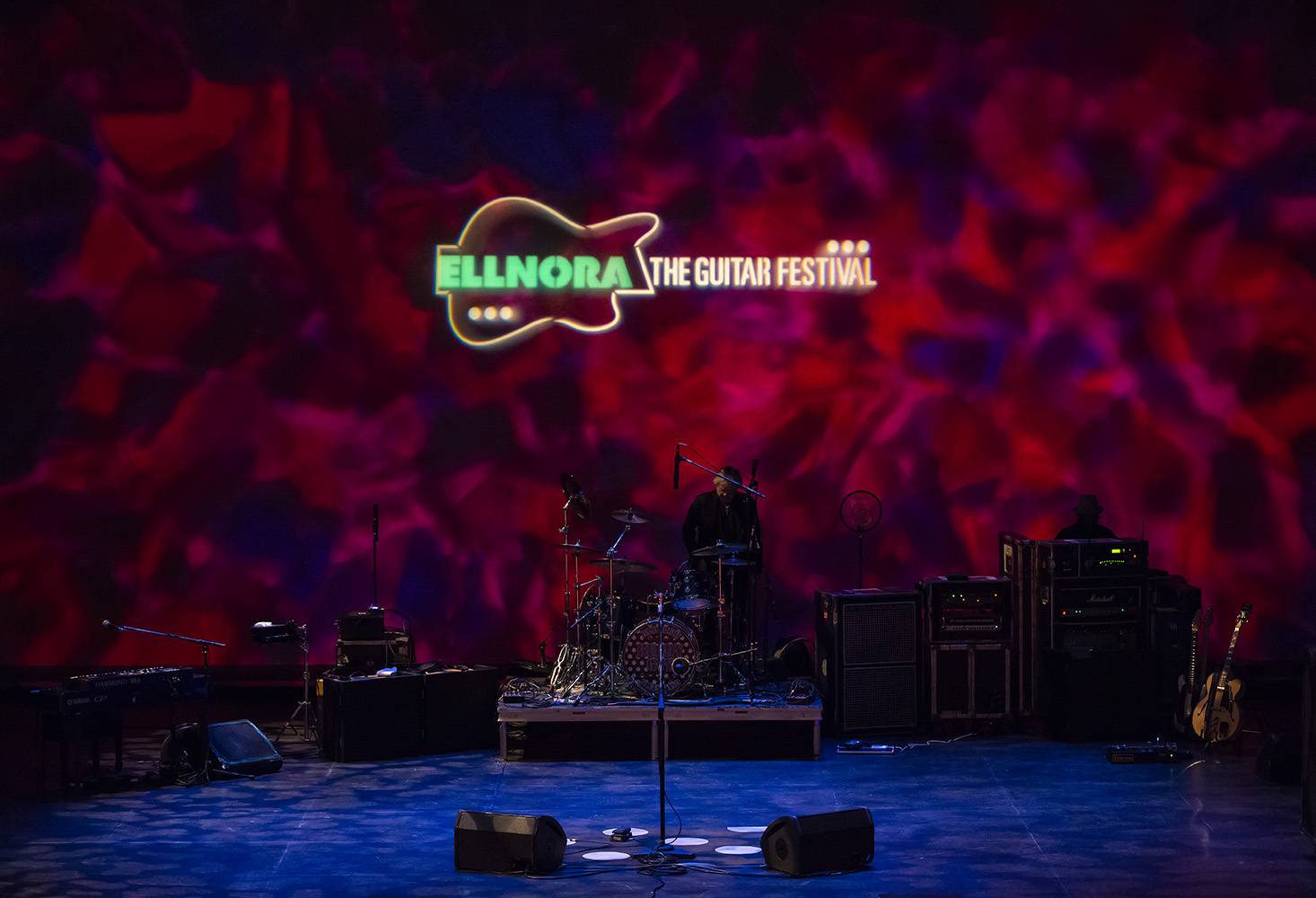
Gavin Good, John Kotnarowski, Julia Hartman, Joseph Ingolia, and Debra Domal contributed to this review.
Photos by Eric Frahm.








